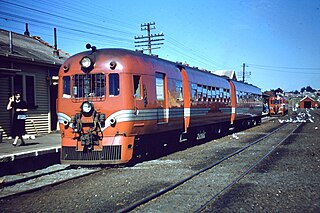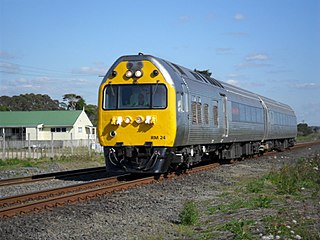The Dargaville Branch is a branch line railway that leaves the North Auckland Line not far south of Whangarei and runs westward to Dargaville. Construction of this relatively short line took approximately two decades, and when it was completed, it linked the now closed Donnelly's Crossing Section with the national rail network. The branch has been closed to all traffic since 2014 and is currently used by a tourist railcart operation.

The NZR RM class Clayton steam rail motor was a unique railcar that was operated by New Zealand Railways (NZR) for New Zealand's national rail network and one of only two steam railcars to operate in New Zealand - the other being 1925's RM class Sentinel-Cammell.

The NZR RM class Edison battery-electric railcar was a railcar that ran in Canterbury, New Zealand for eight years. It was built for New Zealand Railways (NZR) as a prototype for battery-electric railcars. While the railcar, classified "RM 6", was considered the first successful railcar in New Zealand, it was later destroyed in a fire, and battery-electric traction for railcars was not developed further in New Zealand. Two other classes of battery-electric locomotives were introduced about the same time as RM 6, the E class of 1922 and the EB class of 1925.

The NZR RM class Midland railcar was the first successful railcar, and first diesel-powered vehicle, to enter revenue service in New Zealand. Two were built, RM 20 and RM 21, and they ran for five years from 1936 to 1941 before being replaced by larger Vulcan railcars. They operated primarily on the Midland Line and the Greymouth-Hokitika portion of the Ross Branch
The NZR RM class McEwan-Pratt petrol rail motor was the first rail motor to run on New Zealand's national rail network, though it was never used in revenue service. It was built in 1912 at a time when the New Zealand Railways Department (NZR) was seeking alternative methods of providing rural passenger transportation. "Mixed" trains that carried both passengers and freight were typical on country branch lines as there was not sufficient traffic to justify a separate passenger train, but the schedule delays caused by loading and unloading freight during the journey made the mixed trains undesirable.

The NZR RM class Model T Ford railcar was a type of rail motor that operated on New Zealand's national rail network. Only two were built, classified as RM 4 and RM 5, and they were experimental railcars designed in an attempt to offer improved passenger services on quiet country branch lines that served regions with small populations.

The Pleasant Point Museum and Railway is a heritage railway located in the small country town of Pleasant Point in southern Canterbury, New Zealand, inland from Timaru. Its main terminal is located at Pleasant Point station, which was an important stop on the Fairlie Branch. For just over a year from 24 December 1875, Pleasant Point was actually the terminus of the line as construction further inland proceeded, and upon completion of the line, it functioned as a typical country station until closure of the Fairlie Branch came on 2 March 1968. After the line closed, a historical society was formed with the aim of preserving Pleasant Point station, as the original building from 1875 still stood, with the addition of a 1930s booking office. The society ultimately managed to preserve the station, yard, and roughly 2.5 km of track.
The New Zealand Railways Department, NZR or NZGR and often known as the "Railways", was a government department charged with owning and maintaining New Zealand's railway infrastructure and operating the railway system. The Department was created in 1880 and was corporatised on 1 April 1982 into the New Zealand Railways Corporation. Originally, railway construction and operation took place under the auspices of the former provincial governments and some private railways, before all of the provincial operations came under the central Public Works Department. The role of operating the rail network was subsequently separated from that of the network's construction. From 1895 to 1993 there was a responsible Minister, the Minister of Railways. He was often also the Minister of Public Works.

The NZR RM class 88-seaters were a class of railcar used in New Zealand. New Zealand Government Railways (NZR) classed them RM , the notation used for all railcars, numbering the 35 sets from RM100 to RM134. They were the most numerous railcars in NZR service, and were known unofficially as "Articulated", "Eighty Eights", "Twinsets", "Drewrys" or "Fiats". Their purchase and introduction saw the demise of steam-hauled provincial passenger trains and mixed trains.

This is a list of jargon commonly used by railfans and railway employees in New Zealand.
The Kurow Branch was part of New Zealand's national rail network. In the North Otago region of the South Island, it was built in the 1870s to open up the land behind Oamaru for development, and closed in 1983.

The New Zealand Railways Road Services (NZRRS) was a branch of the New Zealand Railways Department and later the New Zealand Railways Corporation. It operated long-distance, tourist and suburban bus services and freight trucking and parcel services. Its name was New Zealand Railways Road Motor Service until mid-1936.

The RM class was the classification used by the New Zealand Railways Department (NZR) and its successors gave to most railcars and railbuses that have operated on New Zealand's national rail network. "RM" stands for Rail Motor. As many types of railcars are operated, class names have been given to each railcar type to differentiate them from others.

The NZR RM class Sentinel-Cammell was a steam-powered railcar operated by the New Zealand Railways Department (NZR). It was the only one of its type to operate in New Zealand, and one of only two steam railcars trialled in the country; the other was the Clayton steam railcar.
The New Plymouth Express was a passenger express train operated by the New Zealand Railways Department (NZR) between Wellington and New Plymouth. It ran from 1886 until 1955 and was sometimes known as the New Plymouth Mail due to the Railway Travelling Post Office carriages included in its consist. The Express was notable amongst NZR's provincial expresses as being both the first and, until the commencement of the Gisborne Express in 1942, the longest in distance travelled.
The New Plymouth Night Express was a passenger express train operated by the New Zealand Railways Department (NZR) that ran between Auckland and New Plymouth. It ran in various forms from 1933 until 1983, though the Express designation was lost in 1956 and later incarnations did not operate at night and terminated in Taumarunui rather than Auckland. The New Plymouth Night Express should not be confused with the New Plymouth Express that operated between New Plymouth and Wellington.
The Palmerston North–Gisborne Line (PNGL) is a secondary main line railway in the North Island of New Zealand. It branches from the North Island Main Trunk at Palmerston North and runs east through the Manawatū Gorge to Woodville, where it meets the Wairarapa Line, and then proceeds to Hastings and Napier in Hawke's Bay before following the coast north to Gisborne. Construction began in 1872, but the entire line was not completed until 1942. The line crosses the runway of Gisborne Airport, one of the world's only railways to do so since Pakistan's Khyber Pass Railway closed.
The NZR RM class Westinghouse railcar was an experimental railcar built by the New Zealand Railways Department (NZR) in 1914. Although not the first railcar to operate in New Zealand, it was the first to enter revenue service.

The NZR RM class Thomas Transmission railcar was an experimental electro-mechanical railcar operated by the New Zealand Railways Department (NZR). It was introduced to service in 1916 and therefore was one of the earliest railcars to operate in New Zealand.
The Moutohora Branch was a branch line railway that formed part of New Zealand's national rail network in Poverty Bay in the North island of New Zealand. The branch ran for 78 km approximately North-West from Gisborne into the rugged and steep Raukumara Range to the terminus at Moutohora. Construction started in 1900, and the line was opened to Moutohora on 26 November 1917.











